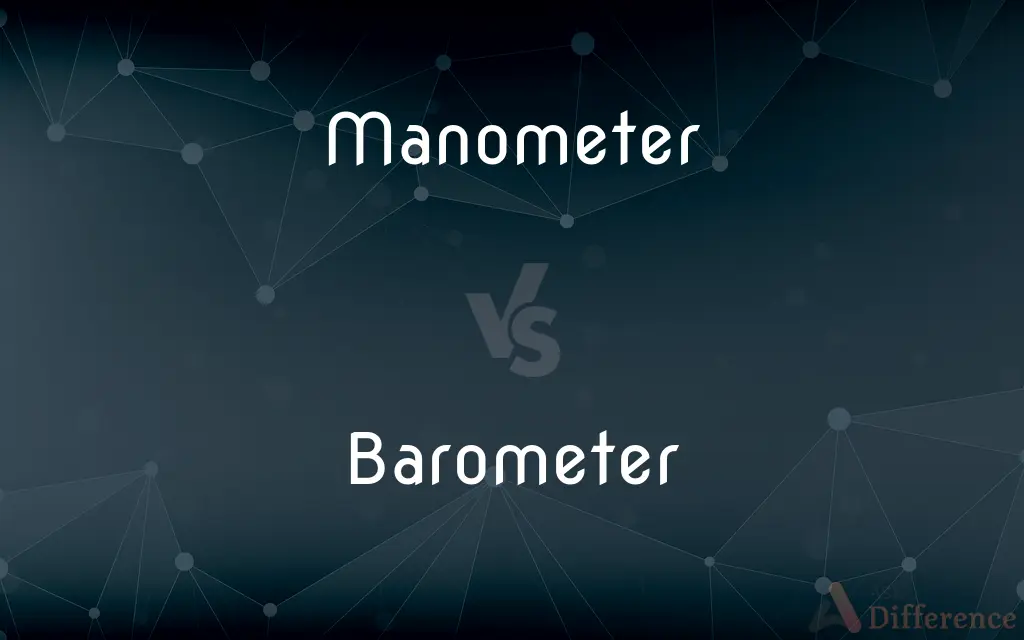Manometer vs. Barometer — What's the Difference?
Edited by Tayyaba Rehman — By Fiza Rafique — Updated on March 15, 2024
A manometer measures pressure differences, often in fluids or gases, while a barometer measures atmospheric pressure, indicating weather changes.

Difference Between Manometer and Barometer
Table of Contents
ADVERTISEMENT
Key Differences
A manometer is an instrument designed to measure the pressure of a fluid or gas by comparing it to a known value or another fluid's pressure. It often consists of a U-shaped tube filled with a fluid, such as mercury or water, where the difference in fluid levels indicates pressure. On the other hand, a barometer is specifically used to measure atmospheric pressure, which is crucial for weather forecasting. Traditional barometers also use mercury or aneroid (without liquid) mechanisms to provide readings that help predict weather changes.
The principle of operation for a manometer involves the displacement of fluid within its tube in response to pressure changes, allowing for the measurement of pressure differences, vacuum pressures, or gauge pressures. Whereas a barometer operates by measuring the weight of the air above it, with changes in atmospheric pressure causing the mercury level or aneroid cell to move, thus providing a measure of the current atmospheric pressure.
Manometers are versatile in application, used in various fields such as laboratory experiments, HVAC systems, and industrial processes to measure and control pressures. They can be designed to measure very precise pressure differences, making them suitable for applications where accuracy is critical. In contrast, barometers are primarily used in meteorology and for general atmospheric pressure monitoring, with their readings being essential for weather prediction and study.
While manometers can be adapted for various scales and fluids to suit specific measurement needs, barometers are generally standardized to measure atmospheric pressure in units such as millibars, inches of mercury, or hectopascals. This standardization is crucial for consistency in weather reporting and forecasting.
Understanding the differences between manometers and barometers is essential for their proper application in scientific, industrial, and meteorological contexts. Each tool serves a specific purpose, with manometers focusing on pressure differences and barometers on atmospheric pressure, reflecting their unique roles in measurement and analysis.
ADVERTISEMENT
Comparison Chart
Purpose
Measures pressure differences in fluids or gases.
Measures atmospheric pressure.
Principle
Uses fluid displacement within a tube to indicate pressure differences.
Measures the weight of the air above, using mercury or aneroid mechanisms.
Applications
Used in labs, HVAC systems, and industrial processes for precise pressure measurements.
Primarily used in meteorology for weather forecasting.
Measurement
Can measure various types of pressures, including vacuum and gauge pressures.
Standardized for atmospheric pressure, crucial for weather prediction.
Units
Various units depending on the application and scale.
Typically measured in millibars, inches of mercury, or hectopascals.
Compare with Definitions
Manometer
A device used to measure the pressure of a fluid or gas.
The technician used a manometer to check the gas pressure in the pipes.
Barometer
Essential for meteorology and weather prediction.
The barometer reading suggested an approaching storm.
Manometer
Can measure pressure differences, vacuum, or gauge pressures.
The engineer calibrated the manometer before measuring the system's vacuum pressure.
Barometer
An instrument that measures atmospheric pressure.
The meteorologist checked the barometer to forecast the weather.
Manometer
Involves a U-shaped tube filled with a fluid for pressure measurement.
The laboratory's manometer indicated a significant pressure difference in the experiment.
Barometer
Measures atmospheric pressure in standardized units.
The barometer indicated a pressure of 1013 millibars, signifying stable weather.
Manometer
Essential for precise pressure measurements in various applications.
HVAC systems often require a manometer for accurate pressure adjustments.
Barometer
Uses mercury or aneroid mechanisms for pressure measurement.
The antique mercury barometer showed a drop in atmospheric pressure.
Manometer
Uses fluid displacement to indicate pressure changes.
The fluid level in the manometer changed, indicating a pressure drop.
Barometer
Reflects changes in weather patterns through pressure readings.
A sudden fall in the barometer reading often predicts bad weather.
Manometer
An instrument used for measuring the pressure of liquids and gases.
Barometer
A barometer is a scientific instrument that is used to measure air pressure in a certain environment. Pressure tendency can forecast short term changes in the weather.
Manometer
A sphygmomanometer.
Barometer
An instrument measuring atmospheric pressure, used especially in forecasting the weather and determining altitude.
Manometer
An instrument to measure pressure in a fluid, especially a double-legged liquid column gauge used to measure the difference in the pressures of two fluids.
Barometer
An instrument for measuring atmospheric pressure, used especially in weather forecasting.
Manometer
An instrument for measuring the tension or elastic force of gases, steam, etc., constructed usually on the principle of allowing the gas to exert its elastic force in raising a column of mercury in an open tube, or in compressing a portion of air or other gas in a closed tube with mercury or other liquid intervening, or in bending a metallic or other spring so as to set in motion an index; a pressure gauge. See Pressure, and Illust. of Air pump.
Barometer
Something that registers or responds to fluctuations; an indicator
Opinion polls serve as a barometer of the public mood.
Manometer
A pressure gauge for comparing pressures of a gas
Barometer
An instrument for measuring atmospheric pressure.
Barometer
Anything used as a gauge or indicator.
Barometer
An instrument for determining the weight or pressure of the atmosphere, and hence for judging of the probable changes of weather, or for ascertaining the height of any ascent.
Barometer
An instrument that measures atmospheric pressure
Common Curiosities
Can a manometer measure atmospheric pressure?
While manometers are primarily used for pressure differences in fluids or gases, certain types can be adapted to measure atmospheric pressure.
Are manometers and barometers interchangeable?
Manometers and barometers are not interchangeable; each serves a specific purpose, with manometers measuring pressure differences and barometers measuring atmospheric pressure.
How does a barometer work?
A barometer works by measuring the weight of the air above it, using either mercury or aneroid mechanisms to provide a measure of atmospheric pressure.
How accurate are manometers?
Manometers can be very accurate, especially when properly calibrated and used in controlled conditions, making them suitable for precise pressure measurements.
What is an aneroid barometer?
An aneroid barometer is a type of barometer that uses a small, flexible metal box called an aneroid cell to measure atmospheric pressure without liquid.
How can a manometer be used in HVAC systems?
In HVAC systems, a manometer can be used to measure and adjust pressures within the system, ensuring optimal performance and safety.
What is a manometer used for?
A manometer is used to measure the pressure of fluids or gases, often indicating pressure differences or vacuum pressures in various applications.
What role do barometers play in weather forecasting?
Barometers are crucial in weather forecasting, as changes in atmospheric pressure measured by barometers can indicate upcoming weather patterns.
What are the common units for barometric pressure?
Common units for barometric pressure include millibars, inches of mercury, and hectopascals.
Can a digital device serve as a manometer or barometer?
Yes, digital devices can be designed to function as either manometers or barometers, offering electronic means to measure pressures or atmospheric pressure.
Why might a barometer reading suddenly drop?
A sudden drop in barometer reading usually indicates a rapid decrease in atmospheric pressure, often associated with the approach of stormy weather.
How do professionals calibrate a manometer?
Professionals calibrate a manometer by comparing its readings to a known pressure standard or using precise instruments to ensure accuracy.
How does atmospheric pressure affect a barometer reading?
Atmospheric pressure affects a barometer reading by causing the mercury level or aneroid cell to move, reflecting the current pressure.
What can cause discrepancies in barometer readings?
Discrepancies in barometer readings can be caused by factors like altitude changes, temperature variations, and calibration errors, affecting the accuracy of atmospheric pressure measurements.
What is the significance of fluid choice in a manometer?
The choice of fluid in a manometer, such as mercury or water, affects its sensitivity and accuracy, with different fluids being suitable for different pressure ranges.
Share Your Discovery

Previous Comparison
Realm vs. Kingdom
Next Comparison
String vs. StrandAuthor Spotlight
Written by
Fiza RafiqueFiza Rafique is a skilled content writer at AskDifference.com, where she meticulously refines and enhances written pieces. Drawing from her vast editorial expertise, Fiza ensures clarity, accuracy, and precision in every article. Passionate about language, she continually seeks to elevate the quality of content for readers worldwide.
Edited by
Tayyaba RehmanTayyaba Rehman is a distinguished writer, currently serving as a primary contributor to askdifference.com. As a researcher in semantics and etymology, Tayyaba's passion for the complexity of languages and their distinctions has found a perfect home on the platform. Tayyaba delves into the intricacies of language, distinguishing between commonly confused words and phrases, thereby providing clarity for readers worldwide.














































